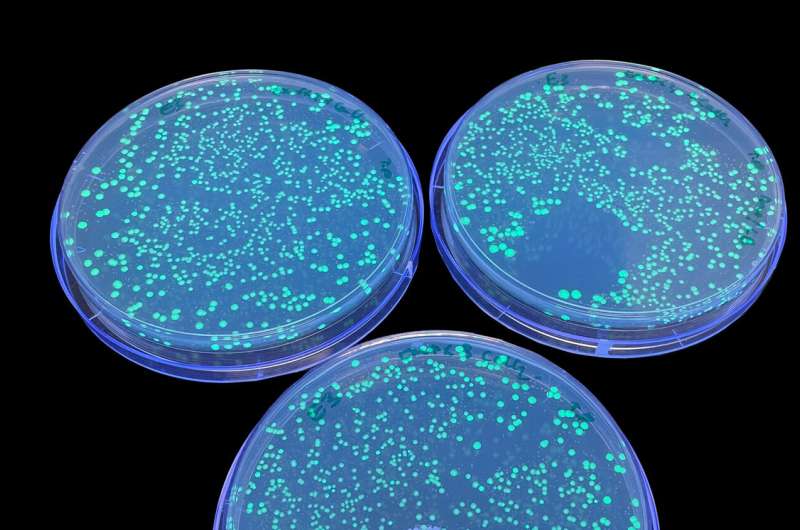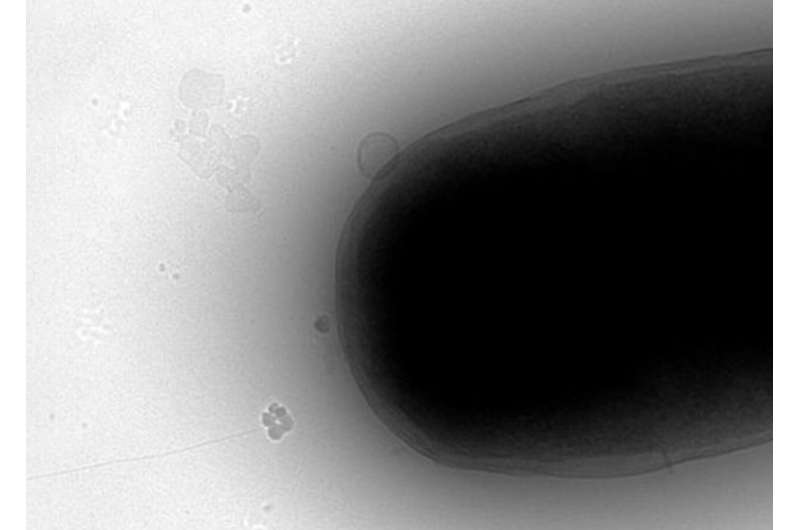This article has been reviewed according to Science X's editorial process and policies. Editors have highlighted the following attributes while ensuring the content's credibility:
fact-checked
peer-reviewed publication
trusted source
proofread
Radio waves can tune up bacteria to become life-saving medicines

Scientists from Australia and the United States have found a new way to alter the DNA of bacterial cells—a process used to make many vital medicines including insulin—much more efficiently than standard industry techniques.
Instead of opening bacteria cell walls with harsh chemicals or high temperatures to insert DNA, the team used high-frequency radio waves, a much gentler approach that led to many more of the cells taking on the DNA and surviving.
The study, led by RMIT University in collaboration with other Australian universities and WaveCyte Biotechnologies in the US, used radio waves at the 18 gigahertz frequency to temporarily 'open the gates' in E. coli bacterial cell walls long enough for genetic material to be inserted.
The cells then closed and continued healthy function.
Radio frequencies can be used to carry everything from mobile phone and satellite data to the energy needed to manipulate bacterial cells in a lab.
Earlier joint work with the Australian Center for Electromagnetic Bioeffects Research demonstrated how high-frequency electromagnetic energy temporarily makes bacterial cells more permeable.
This latest study, "Genetic Transformation of plasmid DNA into Escherichia coli using high frequency electromagnetic energy," published in Nano Letters takes that work a step further by showing the method can be used to safely deliver DNA.
The team's results showed the process to be highly efficient: 91% of the E. coli cells took on the new DNA after exposure to 18GHz radio waves for three minutes.
Using the current industry standard for inserting DNA, known as 'heat shock,' only 77% of the cells take on the DNA and many of those die soon after from the heat exposure. Gentler laser pulse techniques exist but less than 30% of the cells take on the new DNA in that process.
Lead author, RMIT Distinguished Professor Elena Ivanova, said their approach trumped both by being both highly efficient and gentle.

"Our novel, cost-effective method is shown to be highly efficient, but also gentler on the cells as no harsh chemicals or high temperatures are used in this process," said Ivanova, from the School of Science.
"As a result, the cell survival rate was higher than other techniques."
The team's research has also shown this process works in eukaryotic cells—the type we share with animals, fungi and plants, including PC 12 cell line models commonly used in neuroscience research.
"Our focus now is on translating these findings," Ivanova said.
"We have only scratched the surface of the wide range of drug delivery applications this approach could have in microbiome therapeutics and synthetic biology."
RMIT has applied for intellectual property protection for the technique jointly with WaveCyte Biotechnologies, a US company specializing in developing cell and gene therapy technologies.
WaveCyte CEO Dr. Steve Wanjara said they were deeply committed to advancing this technology, having partnered with RMIT from the outset.
"This gentle and highly efficient method holds immense promise for enhancing the affordability and accessibility of critical therapies," Wanjara said.
"We continue to actively work towards translating these findings into tangible applications, focusing on optimizing the technique for mammalian cells. This research has the potential to positively impact millions of lives across the globe, and we are dedicated to making it a reality."
Study first author, Dr. Tharushi Perera from RMIT and Swinburne University, said developing this new application and shedding light on useful aspects of high-frequency electromagnetic energy was "hugely satisfying."
"People hear electromagnetic energy and 5G and think it's bad—possibly due to misinformation or lack of understanding—but, as we have shown here, there are actually beneficial applications," she said.
"My hope is that this can open the door to new life-saving treatments in the long run and look forward to seeing its development."
More information: Palalle G. Tharushi Perera et al, Genetic Transformation of Plasmid DNA into Escherichia coli Using High Frequency Electromagnetic Energy, Nano Letters (2024). DOI: 10.1021/acs.nanolett.3c03464
Journal information: Nano Letters
Provided by RMIT University




















